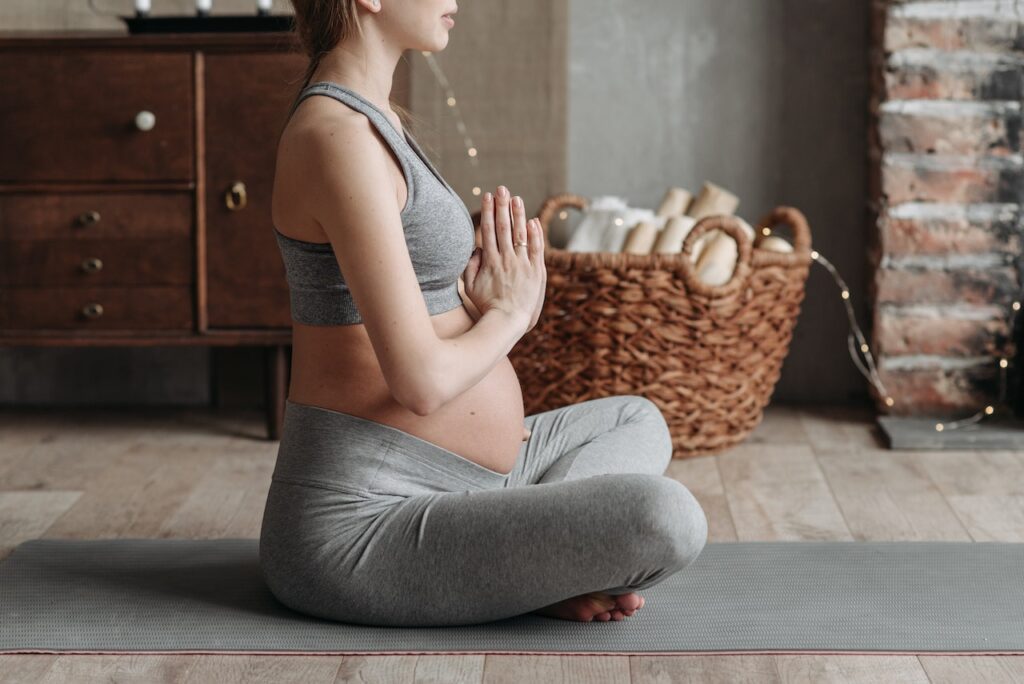Pregnancy is a transformative and beautiful journey but can also bring physical discomfort, hormonal changes, and emotional ups and downs. Prenatal yoga is a valuable practice that can help expectant mothers navigate this transformative period with grace, strength, and peace of mind. In this article, we will explore the benefits of prenatal yoga, provide best practices to ensure a safe and fulfilling practice for pregnant women and introduce the specialized prenatal yoga classes offered at Motherhood Center.
Motherhood Center is a renowned establishment dedicated to supporting women through their journey of motherhood. We understand pregnant women’s unique needs and challenges and have designed specialized prenatal yoga classes to address these specific requirements. Our experienced and certified prenatal yoga instructors provide expert guidance and support, creating a nurturing environment for expectant mothers to practice yoga and connect with their bodies and growing babies.

Benefits of Prenatal Yoga
According to the American Pregnancy Association, prenatal yoga offers a multitude of benefits that support the overall well-being of both the mother and the growing baby. Let’s delve further into the advantages of incorporating prenatal yoga into your pregnancy routine:
Physical Benefits
Enhances flexibility and strength
Prenatal yoga gently stretches and strengthens the muscles, improving overall flexibility and stamina. This increased flexibility can be particularly helpful during childbirth, aiding in a smoother and more comfortable delivery.
Alleviates common discomforts
The practice of prenatal yoga can help alleviate common discomforts associated with pregnancy, such as back pain, sciatica, and swollen ankles. Gentle movements and poses specifically target areas of tension, providing relief and promoting a greater sense of ease in the body.
Improves posture and body awareness
Prenatal yoga emphasizes proper alignment and postural awareness. By practicing poses that promote a neutral spine and balanced musculature, expectant mothers can improve their posture and reduce strain on the back and shoulders.
Increases circulation
The gentle movements and poses in prenatal yoga stimulate blood flow throughout the body, providing enhanced oxygen and nutrient delivery to both the mother and the developing baby. Improved circulation can help reduce swelling, support healthy fetal development, and promote overall well-being.
Mental and Emotional Benefits
Reduces stress and anxiety
Prenatal yoga incorporates mindfulness and deep breathing techniques that activate the relaxation response in the body. By focusing on the breath and staying present in the moment, expectant mothers can reduce stress and anxiety levels, promoting a calmer and more peaceful state of mind.
Boosts mood and promotes emotional well-being
Engaging in prenatal yoga releases endorphins, commonly known as “feel-good” hormones, which can elevate mood and promote a positive outlook. This practice can be particularly valuable for managing mood swings and emotional fluctuations that often accompany pregnancy.
Fosters connection with the baby
Prenatal yoga provides an opportunity for expectant mothers to deepen their bond with their growing baby. Through mindful movements and moments of stillness, pregnant women can cultivate a profound connection with their bodies and the miraculous journey of nurturing new life.
Provides a supportive community
Joining prenatal yoga classes at Motherhood Centers creates a supportive community where pregnant women can connect with others on a similar journey. Sharing experiences, concerns, and triumphs in a nurturing environment fosters a sense of belonging and camaraderie.
The specialized prenatal yoga classes offered at Motherhood Centers embrace these benefits wholeheartedly, providing a comprehensive and nurturing experience that empowers expectant mothers to embrace their journey of motherhood with confidence and vitality.
Now, let’s explore the best practices for prenatal yoga and discover recommended poses and modifications suitable for each trimester of pregnancy.

Best Practices for Prenatal Yoga
While prenatal yoga offers numerous benefits, following some best practices is important to ensure a safe and effective practice. Here are some guidelines to keep in mind:
Consult with your healthcare provider
Before starting prenatal yoga or any exercise regimen, it is crucial to consult with your healthcare provider to ensure it is safe for you and your baby. They can provide personalized guidance based on your specific needs and medical history.
Finding a qualified prenatal yoga instructor
Look for a certified prenatal yoga instructor who has the knowledge and experience to guide you safely through the practice. Motherhood Center in Houston offers specialized prenatal yoga classes led by experienced instructors who are well-versed in addressing the unique needs of expectant mothers.
Safety precautions during prenatal yoga
Be mindful of your body’s limits and avoid overexertion. Pregnancy hormones can make your joints more flexible, so listening to your body and avoiding pushing yourself too far is important. Stay hydrated throughout your practice and take breaks as needed.
Modify poses as necessary
As your body changes during pregnancy, certain yoga poses may need to be modified to ensure your comfort and safety. Your instructor at Motherhood Center will guide you through appropriate modifications, helping you adapt the poses to suit your individual needs.
Practice mindfulness and body awareness
During your prenatal yoga sessions, cultivate mindfulness by staying present in the moment and connecting with your breath and body. Pay attention to how each pose feels and make adjustments accordingly.
By incorporating these best practices and participating in the prenatal yoga classes offered at Motherhood Centers in Houston, you can fully embrace the myriad benefits of prenatal yoga in a secure and nurturing environment. The highly experienced instructors at Motherhood Centers will offer expert guidance, ensuring your practice is safe, effective, and tailored to your unique needs.
Recommended Prenatal Yoga Poses
During pregnancy, it’s important to practice prenatal yoga poses that are safe, gentle, and supportive of your changing body. Here are some recommended poses for each trimester:
First Trimester
Cat-Cow Pose (Marjaryasana-Bitilasana)
This gentle flowing movement helps to release tension in the spine, improve flexibility, and promote a sense of relaxation.
Modified Triangle Pose (Trikonasana)
This pose stretches the sides of the body, promotes balance, and helps alleviate any early pregnancy discomfort.
Legs-Up-The-Wall Pose (Viparita Karani)
This restorative pose helps to relieve fatigue, reduce swelling in the legs, and promote healthy blood circulation.
Second Trimester
Modified Warrior II Pose (Virabhadrasana II)
This pose strengthens the legs, opens the hips, and improves balance and stability. Modify by widening the stance and avoiding deep lunges.
Supported Squat Pose (Malasana with a block)
This pose helps to open the hips, strengthen the pelvic floor, and prepare the body for childbirth. Use a block or support under the hips for added stability and comfort.
Bound Angle Pose (Baddha Konasana)
This pose gently stretches the inner thighs, improves flexibility, and encourages relaxation. Support the knees with pillows or blocks if needed.
Third Trimester
Supported Child’s Pose (Balasana)
This restorative pose provides gentle stretching for the lower back, hips, and shoulders, while promoting relaxation and stress relief. Use pillows or bolsters for support.
Modified Bridge Pose (Setu Bandhasana)
This pose strengthens the glutes, opens the chest, and relieves lower back tension. Use props such as a bolster or block under the hips for added support.
Pelvic Floor Exercises (Kegels)
These exercises strengthen the pelvic floor muscles, which play a vital role in supporting the uterus, bladder, and bowel. Practice regular Kegels to prepare for childbirth and promote postpartum recovery.
Remember to listen to your body, take breaks when needed, and modify the poses to suit your comfort level. Each pregnancy is unique, so honoring your body’s needs and limitations is important.
Incorporating these recommended prenatal yoga poses into your practice can enhance your physical and mental well-being throughout your pregnancy journey. The experienced instructors at Motherhood Centers in Houston can guide you through these poses, ensuring proper alignment, modifications, and adjustments to suit your individual needs.
Modifications for Each Trimester
As your pregnancy progresses, your body goes through significant changes. It’s crucial to make modifications to your yoga practice to accommodate these changes and ensure safety. Here are some general guidelines for modifications during each trimester:
First trimester modifications
- Avoid lying flat on your back for an extended period as it can compress the vena cava, affecting blood flow to the baby. Use props to elevate your upper body.
- Focus on gentle stretching and relaxation exercises to support overall well-being.
Second trimester modifications
- Avoid deep twists or poses that compress the abdomen. Instead, opt for gentle twists that keep the belly free and open.
- Incorporate more strengthening exercises to support the growing weight of the baby and maintain stability.
Third trimester modifications
- Avoid poses that require lying flat on your belly or deep backbends. Modify these poses by using props or practicing modified versions
to ensure comfort and safety.
- Choose standing or seated poses that promote stability and avoid poses that put excessive pressure on the pelvic floor.
- Incorporate more relaxation and restorative poses to relieve discomfort and promote relaxation.
Remember, these modifications are general guidelines. Always consult your prenatal yoga instructor for personalized modifications based on your needs and pregnancy journey.
 Tips for Practicing Prenatal Yoga at Home
Tips for Practicing Prenatal Yoga at Home
Practicing prenatal yoga at home provides you with the flexibility and convenience to nurture your mind and body throughout your pregnancy journey. Here are some helpful tips to make your home practice safe, enjoyable, and effective:
Create a Safe and Comfortable Space
Designate a quiet and clutter-free area in your home where you can roll out your yoga mat. Ensure the space is well-ventilated and free from any hazards or obstacles that could interfere with your practice.
Gather Essential Props
Collect the necessary props to support your practice. This may include a yoga mat, bolsters, blocks, blankets, and straps. These props will aid in modifications and provide extra support for poses as needed.
Warm-up and Cool-down
Begin your prenatal yoga practice with a gentle warm-up sequence to prepare your body for movement. Incorporate stretches for the neck, shoulders, back, and hips. After the practice, allow time for a soothing cool-down period, where you can rest in a comfortable position and focus on deep relaxation.
Modify Poses for Your Comfort
As your body changes during pregnancy, certain poses may require modifications to accommodate your growing belly and physical limitations. Follow the modifications your prenatal yoga instructor provides or consult prenatal yoga resources for guidance on pose modifications suitable for each trimester.
Listen to Your Body
Pregnancy is a unique journey, and every woman’s experience is different. Pay close attention to how your body feels during each pose. If a pose feels uncomfortable or causes pain, modify or skip it altogether. Honoring your body’s signals and practicing within your comfort zone is important.
Practice Mindful Breathing
Incorporate deep breathing exercises into your prenatal yoga practice. Focus on slow, steady inhales and exhales, allowing the breath to nourish your body and calm your mind. Deep breathing promotes relaxation, reduces stress, and increases oxygen flow to both you and your baby.
Stay Hydrated
Drink plenty of water before, during, and after your prenatal yoga practice to stay hydrated. Hydration is essential for supporting your body’s functions, maintaining healthy blood flow, and regulating body temperature.
Set Realistic Goals
Be realistic and compassionate with yourself as you establish a regular home practice. Some days, you may have more energy and time to dedicate to yoga, while other days you may need to modify or shorten your practice. Embrace the ebb and flow of your energy levels and adapt your practice accordingly.
Seek Online Resources and Classes
Explore reputable online resources, prenatal yoga videos, and virtual classes that provide guided prenatal yoga sessions. Many yoga studios and instructors offer online options, including Motherhood Centers, where you can access professional guidance and expert instruction from your home.
Precautions and Contraindications
While prenatal yoga is generally safe for most pregnant women, there are certain precautions and contraindications to be aware of. It’s important to listen to your body and consult with your healthcare provider if you have any concerns or medical conditions. Here are some general precautions:
High-Risk Pregnancy
Suppose you have a high-risk pregnancy or complications such as preterm labor, preeclampsia, placenta previa, or a history of recurrent miscarriages. In that case, it is important to consult your healthcare provider before engaging in prenatal yoga. They can assess your specific situation and advise you on the appropriateness of practicing yoga.
Injuries or Conditions
If you have any pre-existing injuries, musculoskeletal conditions, or chronic health issues, it is crucial to inform your prenatal yoga instructor and healthcare provider. They can recommend modifications or alternative poses to ensure your safety and comfort during the practice.
Overexertion and Fatigue
Pregnancy is a time when your body goes through significant changes, and it’s important to listen to your body’s signals. Avoid overexertion, as it can lead to fatigue, overheating, and potential risks. Take breaks as needed and modify poses to suit your energy levels and physical capabilities.
Avoid Certain Poses
During prenatal yoga, it is advisable to avoid poses that involve deep twists, intense backbends, or inversions that may compress the abdomen or put pressure on the uterus. Poses that require lying flat on the belly or back for an extended period should also be avoided after the first trimester.
Listen to Your Body
The most important aspect of prenatal yoga is listening to your body and respecting its limitations. If a pose feels uncomfortable, causes pain, or doesn’t feel right, modify or skip it. Every pregnancy is unique, and what works for others may not be suitable for you.
You can ensure a safe and enjoyable prenatal yoga practice by being mindful of these precautions and contraindications. Always prioritize your health and consult with healthcare professionals for personalized guidance based on your unique circumstances.
Conclusion
Prenatal yoga is a transformative practice that offers numerous benefits for expectant mothers, both physically and emotionally. It provides a nurturing space for you to connect with your body, cultivate relaxation, and prepare for motherhood. Incorporating prenatal yoga into your routine can enhance your overall well-being, reduce pregnancy discomfort, and develop valuable skills for labor and childbirth.
To experience the full advantages of prenatal yoga, consider joining the prenatal yoga classes offered at Motherhood Center in Houston. Our experienced instructors are dedicated to providing a safe and supportive environment for expectant mothers like you. Whether you are a beginner or have prior yoga experience, our classes are tailored to meet your specific needs during each trimester of pregnancy.
Motherhood Center offers a wide range of prenatal yoga classes catering to different skill levels and preferences. Our highly trained instructors will guide you through a series of gentle poses, breathing techniques, and relaxation exercises to help you navigate pregnancy’s physical and emotional challenges. The community atmosphere of our classes allows you to connect with other expectant mothers, share experiences, and build lasting friendships.
Don’t miss out on the opportunity to nurture yourself and your growing baby through the practice of prenatal yoga. Contact us today or visit our website to learn more about the prenatal yoga classes at Motherhood Center in Houston. Our friendly staff is ready to answer any questions you may have and assist you in choosing the class that best suits your needs.
Start your prenatal yoga practice today and discover the profound benefits it can bring to your mind, body, and spirit.
FAQs
Is it safe to practice prenatal yoga during all stages of pregnancy?
Yes, prenatal yoga can be practiced throughout pregnancy. However, it’s important to consult with your healthcare provider and make modifications as needed.
Can I practice prenatal yoga if I’m a beginner?
Absolutely! Prenatal yoga is suitable for beginners as well. It is designed to cater to all levels of experience and fitness. Just make sure to start with gentle poses and gradually build your practice over time.
Can prenatal yoga help with labor and delivery?
Yes, prenatal yoga can be beneficial in preparing the body for labor and delivery. It helps strengthen the muscles needed during childbirth, improves flexibility, and promotes relaxation techniques that can be helpful during labor.
How often should I practice prenatal yoga?
Aiming for at least two to three sessions of prenatal yoga per week is recommended. Consistency is key to experiencing the full benefits. However, listen to your body and adjust the frequency based on your comfort and energy levels.
Can I continue my regular yoga practice during pregnancy?
It depends on your circumstances. In general, switching to a prenatal yoga practice specifically designed for pregnancy is advisable. Regular yoga classes may not address the unique needs and modifications required during pregnancy.

 Tips for Practicing Prenatal Yoga at Home
Tips for Practicing Prenatal Yoga at Home

